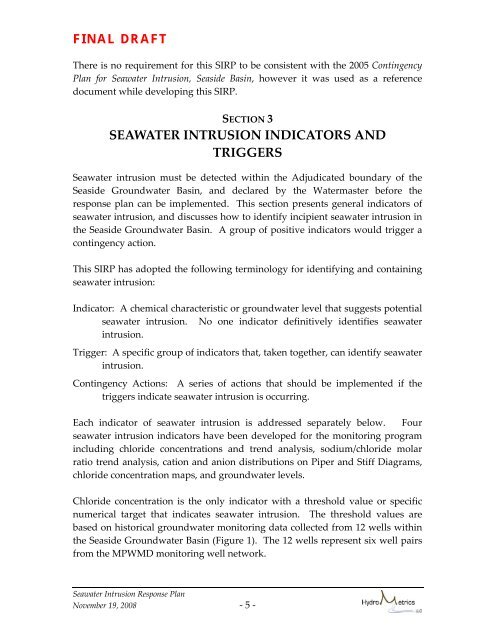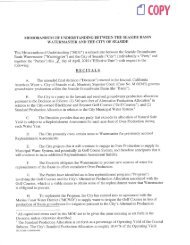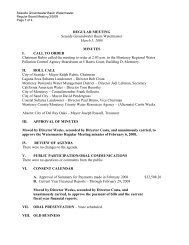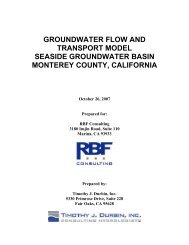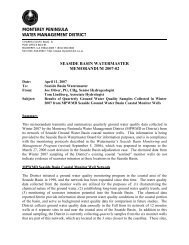indicators of seawater intrusion - Seasidebasinwatermaster.org
indicators of seawater intrusion - Seasidebasinwatermaster.org
indicators of seawater intrusion - Seasidebasinwatermaster.org
- No tags were found...
Create successful ePaper yourself
Turn your PDF publications into a flip-book with our unique Google optimized e-Paper software.
FINAL DRAFTThere is no requirement for this SIRP to be consistent with the 2005 ContingencyPlan for Seawater Intrusion, Seaside Basin, however it was used as a referencedocument while developing this SIRP.SECTION 3SEAWATER INTRUSION INDICATORS ANDTRIGGERSSeawater <strong>intrusion</strong> must be detected within the Adjudicated boundary <strong>of</strong> theSeaside Groundwater Basin, and declared by the Watermaster before theresponse plan can be implemented. This section presents general <strong>indicators</strong> <strong>of</strong><strong>seawater</strong> <strong>intrusion</strong>, and discusses how to identify incipient <strong>seawater</strong> <strong>intrusion</strong> inthe Seaside Groundwater Basin. A group <strong>of</strong> positive <strong>indicators</strong> would trigger acontingency action.This SIRP has adopted the following terminology for identifying and containing<strong>seawater</strong> <strong>intrusion</strong>:Indicator: A chemical characteristic or groundwater level that suggests potential<strong>seawater</strong> <strong>intrusion</strong>. No one indicator definitively identifies <strong>seawater</strong><strong>intrusion</strong>.Trigger: A specific group <strong>of</strong> <strong>indicators</strong> that, taken together, can identify <strong>seawater</strong><strong>intrusion</strong>.Contingency Actions: A series <strong>of</strong> actions that should be implemented if thetriggers indicate <strong>seawater</strong> <strong>intrusion</strong> is occurring.Each indicator <strong>of</strong> <strong>seawater</strong> <strong>intrusion</strong> is addressed separately below. Four<strong>seawater</strong> <strong>intrusion</strong> <strong>indicators</strong> have been developed for the monitoring programincluding chloride concentrations and trend analysis, sodium/chloride molarratio trend analysis, cation and anion distributions on Piper and Stiff Diagrams,chloride concentration maps, and groundwater levels.Chloride concentration is the only indicator with a threshold value or specificnumerical target that indicates <strong>seawater</strong> <strong>intrusion</strong>. The threshold values arebased on historical groundwater monitoring data collected from 12 wells withinthe Seaside Groundwater Basin (Figure 1). The 12 wells represent six well pairsfrom the MPWMD monitoring well network.Seawater Intrusion Response PlanNovember 19, 2008 - 5 -


